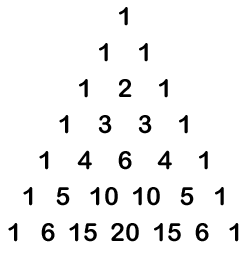I have a small assignment where I have to use a 2d array to produce Pascal’s triangle. Here is my code, and it works. There is an extra credit opportunity if I display the triangle like so:

However, my spacing is not formatted like that. it simply displays the numbers all lined up on the left. its hard to describe but if you run it you will see what I mean.
Here is my code:
public class Pascal {
public static final int ROW = 16;
public static void main(String[] args) {
int[][] pascal = new int[ROW + 1][];
pascal[1] = new int[1 + 2];
pascal[1][1] = 1;
for (int i = 2; i <= ROW; i++) {
pascal[i] = new int[i + 2];
for (int j = 1; j < pascal[i].length - 1; j++) {
pascal[i][j] = pascal[i - 1][j - 1] + pascal[i - 1][j];
}
}
for (int i = 1; i <= ROW; i++) {
for (int j = 1; j < pascal[i].length - 1; j++) {
System.out.print(pascal[i][j] + " ");
}
System.out.println();
}
}
}
If someone could help me figure out how to add the correct spacing to my program to produce the output desired in the picture, that would be great. I know I need to put a System.out.print(" ") somewhere. I just dont know where.
Advertisement
Answer
Here I had modified your code, it prints wonderfully for ROW size till 13, because of the limitation of my console window:
import java.util.*;
public class Pascal {
public static final int ROW = 12;
private static int max = 0;
public static void main(String[] args) {
int[][] pascal = new int[ROW + 1][];
pascal[1] = new int[1 + 2];
pascal[1][1] = 1;
for (int i = 2; i <= ROW; i++) {
pascal[i] = new int[i + 2];
for (int j = 1; j < pascal[i].length - 1; j++) {
pascal[i][j] = pascal[i - 1][j - 1] + pascal[i - 1][j];
String str = Integer.toString(pascal[i][j]);
int len = str.length();
if (len > max)
max = len;
}
}
for (int i = 1; i <= ROW; i++) {
for (int k = ROW; k > i; k--)
System.out.format("%-" + max + "s", " ");
for (int j = 1; j < pascal[i].length - 1; j++)
System.out.format("%-" + (max + max) + "s", pascal[i][j]);
System.out.println();
}
}
}
Output:
1
1 1
1 2 1
1 3 3 1
1 4 6 4 1
1 5 10 10 5 1
1 6 15 20 15 6 1
1 7 21 35 35 21 7 1
1 8 28 56 70 56 28 8 1
1 9 36 84 126 126 84 36 9 1
1 10 45 120 210 252 210 120 45 10 1
1 11 55 165 330 462 462 330 165 55 11 1